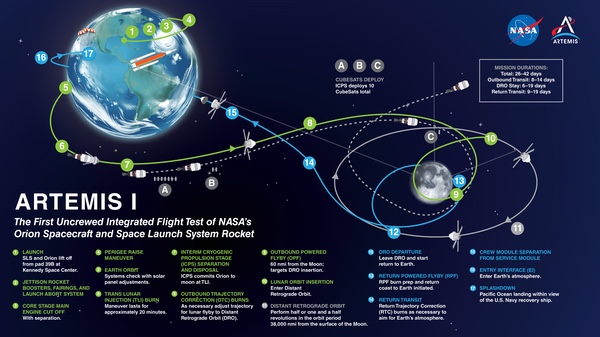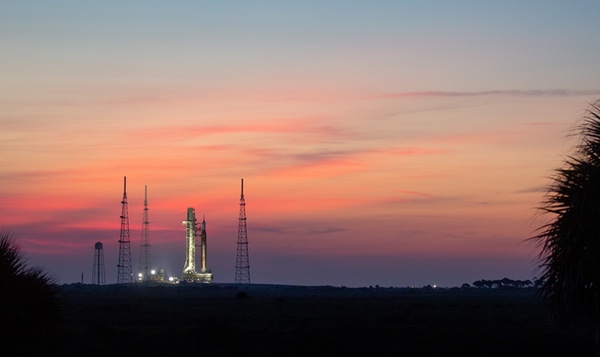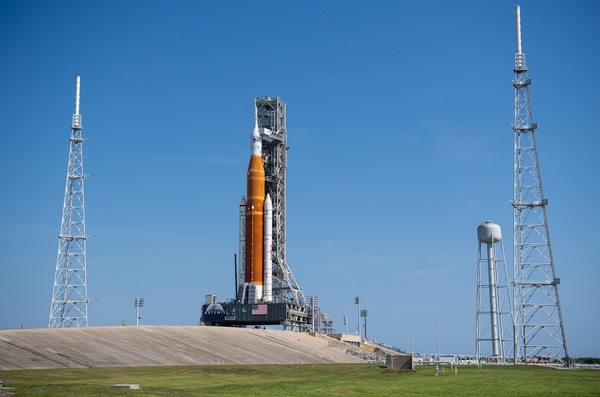The time has finally come for Artemis 1by Jeff Foust
|
| “We are in the final stretch,” Blackwell-Thompson said of Artemis 1 plans earlier this month. |
That may finally change next week. As soon as 8:33 am EDT on August 29, the first SLS is scheduled to lift off from LC-39B at the Kennedy Space Center with an uncrewed Orion spacecraft on top. That time marks the start of a two-hour window for the launch, with another two-hour opportunity starting at 12:48 pm EDT September 2. A third launch window opens September 5—Labor Day—at 5:12 pm EDT, for 90 minutes.
As the months leading up to those Artemis 1 launch dates turned into weeks, agency officials have been increasingly confident that everything is, at long last, in place for a launch. That confidence came from a series of fueling and countdown tests called wet dress rehearsals: three in April and one in June that, while never getting to the planned stopping point, exercised the launch vehicle and ground systems enough for agency officials to conclude they were ready to finally move on to launch.
That confidence was in evidence last week, when NASA moved up the rollout of the SLS from the Vehicle Assembly Building to LC-39B by more than 24 hours, having completed all the work they needed ahead of schedule and giving crews some additional margin at the pad to prepare SLS and Orion for launch.
“We are in the final stretch,” Charlie Blackwell-Thompson, Artemis 1 launch director at KSC, said at a briefing earlier this month about the mission. As for an August 29 launch, “We are on plan for that at this time.”
There have still been some issues to deal with in the final weeks. One of them is with the rocket’s flight termination system (FTS), which allows range safety to detonate the vehicle if it goes off course. The FTS system is installed in an intertank region of the SLS’s core stage, an area that can only be accessed while the rocket is in the VAB. Completing that work, including installing its batteries, was one of the last things done on the SLS before rollout.
The problem is that the Space Force, which operates the Eastern Range, only certified the FTS for 20 days after its batteries are installed and tested, which takes place 15 days before the first launch attempt. That would have allowed NASA to proceed with launch opportunities on August 29 and September 2, but the clock would have run out before the September 5 launch. NASA managers said in briefings earlier in the month that they were working with the Space Force on extending that 20-day period for the FTS.
On August 12, NASA announced it had received a waiver from the Space Force extending the lifetime of the FTS from 20 to 25 days, enough to enable a September 5 launch if needed.
The FTS, though, could factor into future launch delays, though. If, for some combination of reasons, Artemis 1 does not launch by September 5, the vehicle will have to roll back to the VAB to refresh the FTS, since it cannot be accessed on the pad. Even if there was no other work needed to get SLS and Orion ready for another launch, agency officials said that the process of rolling back to the VAB and returning to the pad would make it difficult to launch in the next available opportunity, which opens September 20 and runs through October 4.
“That would be a real challenge for us, to be honest with you,” said Cliff Lanham, senior vehicle operations manager in NASA’s Exploration Ground Systems program, of launching during that timeframe during a July briefing. “But we would certainly give it our best shot.”
 An overview of the Artemis 1 mission (larger version). (credit: NASA) |
Mission overview
For all the attention that the launch itself is getting, far less is going to the overall Artemis 1 mission. That SLS launch only sets the stage for a test flight lasting up to 42 days that will put the Orion spacecraft through its paces and demonstrate that the spacecraft, under development in one form or another for more than 15 years, is finally ready to carry astronauts.
The top objective of Artemis 1 won’t come until the end of the mission, when the spacecraft reenters at speeds of around 40,000 kilometers per hour. That will be the first test of Orion’s heat shield at those velocities.
| If the return powered flyby doesn’t work, LaBrode said, “then it’s a loss of the vehicle.” |
“It’s certainly very important that we accomplish that objective as part of Artemis 1 and really demonstrate what we know from our ground testing to be the capabilities of that heat shield,” said Howard Hu, NASA Orion program manager, at a briefing early this month.
The mission’s second objective is to test all of the capabilities of SLS and Orion during the flight, including life support, propulsion, and communications, among others. “It’s really important that we have a good opportunity to test those systems together on Artemis 1,” Hu said.
A third objective is to recover the Orion capsule itself after splashdown. Part of that is to test recovery operations for future crewed missions, as well as to return the capsule for analysis. That splashdown will take place about 100 kilometers off the coast of San Diego, California, with a naval vessel supporting the recovery effort. (One factor driving the timing of Artemis launch attempts is a requirement that splashdown take place during daylight.)
Melissa Jones, NASA Artemis 1 recovery director, said at a briefing that the requirement for future Artemis missions is go from splashdown to having astronauts in the “med bay” on the recovery ship within two hours. “I think we can beat that pretty significantly: we’re looking at about 80 minutes,” she said.
Orion will be on its way to the Moon quickly after liftoff. Orion and the SLS upper stage, the Interim Cryogenic Propulsion Stage (ICPS), separate from the core stage a little more than eight minutes after liftoff. Fifty-one minutes after liftoff, the ICPS fires for a brief burn to raise its orbit perigee.
The big burn, translunar injection (TLI), comes about an hour and 37 minutes after liftoff, with the upper stage firing for 18 minutes to send Orion towards the Moon, with no margin for error. “The upper stage is pretty much a fire-and-forget vehicle,” said Judd Frieling, Artemis 1 ascent/entry flight director. “If it doesn’t perform the perigee raise maneuver or it doesn’t perform the TLI maneuver, Orion does not have the commodities to get to the Moon by itself. It has to be put on that TLI by that upper stage and it has to be at the times that we prescribe.”
Orion will separate from ICPS shortly after that burn and head to the Moon. Five days later, it will pass about 100 kilometers from the lunar surface during a maneuver called the outbound powered flyby, using the main engine in its service module. That will set it up, four days later, to go into a distant retrograde orbit (DRO) around the Moon.
Artemis 1 is the only mission of the Artemis program planned to use the DRO, once considered for the Asteroid Redirect Mission and Deep Space Gateway programs. Artemis 3 and later missions will instead go into the elliptical near-rectilinear halo orbit that allows for access to the lunar poles, while Artemis 2, the first crewed flight, will go on a free-return trajectory around the Moon.
NASA says it’s using the DRO for Artemis 1 because it’s a very stable orbit. “It takes very little prop [propellant] to stay in that orbit,” said Debbie Korth, Orion program deputy manager at NASA’s Johnson Space Center. “We can do a very long mission where we can wring out the systems.”
| “If we can get the SLS off at the end of this month or early September, we hope that they’ll all have an opportunity to be able to fly,” Bleacher said of the ten cubesats on board. |
Orion will stay in the DRO for about two weeks, performing a burn to exit DRO 24 days into the mission. That will bring it back to the vicinity of the Moon 11 days later for the return powered flyby, which will put the spacecraft on course for the Earth, splashing down 42 days after liftoff.
Those two close flybys, on the way out and back, are critical to the mission. “The margin for error is small,” said Rick LaBrode, lead Artemis 1 flight director. If the outbound powered flyby doesn’t take place as planned, Orion won’t make it to DRO. “We’ll still be able to bring Orion safely back, but we won’t be able to accomplish all of our mission objectives.”
If the return powered flyby doesn’t work, he added, “then it’s a loss of the vehicle.”
 SLS arrive at the pad last week for the Artemis 1 launch. (credit: NASA/Joel Kowsky) |
Other mission objectives
Artemis 1 has a fourth mission objective beyond reentry, testing of SLS and Orion systems, and recovering Orion after splashdown. The “additional flight test objectives” is a catch-all for a range of other tests on Orion during the mission, testing various spacecraft technologies from radiators to cameras mounted on the tips of its solar arrays.
There are also payloads inside Orion that will be tested during the flight. Mannequins will measure the radiation environment that astronauts will be exposed to during a flight as well as the effectiveness of a vest to shield astronauts from that radiation. Lockheed Martin, working with Cisco WebEx and Amazon, will test the use of Amazon’s Alexa voice-based computing system inside Orion.
Rob Chambers, director of commercial civil space strategy at Lockheed Martin, said in a briefing last week he expected to get a puzzled response from Amazon when contacting them about participating in the project, called Callisto. “Instead, they explained that one of the progenitors for Alexa, one of the thoughts that they had, if you will, was the voice computer from the Starship Enterprise,” he recalled. “In some ways, they said, they had been kind of waiting for this moment.”
Artemis 1 will, in addition to Orion and its payloads inside, fly ten cubesat secondary payloads. The ten 6U cubesats, from NASA, international partners, and other organizations, will carry out a variety of missions, from orbiting and even landing on the Moon to testing deep-space communications technologies and using a solar sail to fly by an asteroid.
That is, if the cubesats work. NASA required the cubesats to be delivered nearly a year ago so they could be installed on a payload adapter, on top of which Orion was attached. Once Orion was installed, those cubesats were inaccessible. While five of the cubesats had the ability to recharge their batteries, the other five, for various reasons, did not, raising concerns that by the time they launch, their batteries will be dead. Those cubesats have solar panels, but a lack of battery power could disrupt critical early operations after deployment from the SLS.
“We’re trying to work through the preparations and get the SLS ready to fly. That’s the best thing we can do at this point,” said Jacob Bleacher, NASA chief exploration scientist, when asked about the battery issues with the cubesats at a briefing last week. “If we can get the SLS off at the end of this month or early September, we hope that they’ll all have an opportunity to be able to fly.”
Craig Hardgrove, principal investigator for one of the cubesats, LunaH-Map, said the inability to charge that cubesat came out of prelaunch reviews. “The SLS program didn’t feel comfortable with us charging,” he said, but didn’t elaborate. Even if battery levels drop below the minimum needed to start its flight computer after deployment, he said two exposed solar arrays should generate enough power to charge the batteries “in not too much time.”
Another cubesat identified by NASA as not being able to charge is Team Miles, which won its spot on the mission through the Centennial Challenges prize program. Wesley Faler, leader of Team Miles, said that was a deliberate choice. “We had an opportunity to charge but we opted out of it,” he said, based on the low rate of battery discharge. “We figured, why rock the boat and introduce the variable of recharging?”
Planning for the future
As NASA moves into the final stages of preparations for Artemis 1, it is also moving ahead on Artemis 2, the first crewed flight. That mission is likely to launch no earlier than late 2024, depending in part on the outcome of Artemis 1.
| “As long as you are healthy,” Wiseman said, “we’re going to load you on a rocket and shoot you off the planet.” |
NASA has yet to announce who will fly on the mission, although one of the four seats will go to a Canadian astronaut as part of an agreement between NASA and the Canadian Space Agency whereby Canada provides a robotic arm for the lunar Gateway. Canada, in return, gets a seat on Artemis 2 and a later Gateway mission.
“The question everyone will ask is when are we assigning a crew to Artemis 2? We hope that will be later this year,” said Reid Wiseman, NASA chief astronaut, at a briefing earlier this month.
In late 2020, NASA announced the selection of 18 astronauts as part of an “Artemis Team” that would be considered for future Artemis flight assignments. That announcement came at a National Space Council meeting where outgoing Vice President Mike Pence announced the 18 astronauts, calling them “heroes of the future.”
However, Wiseman said that the entire astronaut corps of 42 active astronauts (with ten more in training) would be considered for Artemis 2 and later missions, not just the Artemis Team astronauts, a point he emphasized several times at that briefing.
“The way I look at it, any one of our 42 active astronauts is eligible for an Artemis mission,” he said, a point he emphasized several times during the briefing. “We want to assemble the right team for this mission.”
NASA, he also said, was changing radiation standards based on recommendations from a National Academies study last year, doing away with separate standards based on age and gender to a single one. Doing so, that study argued, would provide more flight opportunities for women who previously had a lower radiation standard.
“As long as you are healthy,” he said, “we’re going to load you on a rocket and shoot you off the planet.” But first, Artemis 1 has to demonstrate that the rocket, and the spacecraft, are ready for astronauts.
Note: we are using a new commenting system, which may require you to create a new account.
